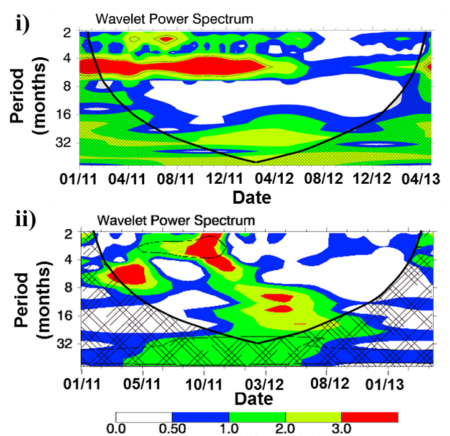
Wavelet spectrum of chloride in i) contaminated aquifer and ii) naturally reduced zone of the Rifle site.
Scientific Achievement
A novel wavelet-entropy approach was used to identify the governing transport and biogeochemical factors causing geochemical hot moments and their distribution along different transects of a contaminated river floodplain.
Significance and Impact
- Geochemical hot moments were found to be primarily transport-related/hydrologically-driven at the site except within a naturally reduced zone, where hot moments were dominated by lithologic characteristics.
- This study presents a transferrable approach for water quality managers in identifying hot moments of contaminants in other settings.
Research Details
- We interrogated complex, multivariate geochemical datasets to identify geochemical hot moments in a floodplain environment.
- Geochemical hot moments were associated with seasonal hydrologic variability (∼4 months) in the contaminated aquifer and with annual hydrologic cycle and residence times (∼12 months) in the seep zone.
- Hot moments associated with a naturally reduced zone within the aquifer were found to be biogeochemically-driven, with a different dominant frequency (∼3 months), in contrast to what was observed in other regions of the floodplain.
Citation
Arora, B., Dwivedi, D., Hubbard, S.S., Steefel, C.I. and Williams, K.H., 2016. Identifying geochemical hot moments and their controls on a contaminated river floodplain system using wavelet and entropy approaches. Environmental Modelling & Software, 85, pp.27-41. DOI: 10.1016/j.envsoft.2016.08.005
